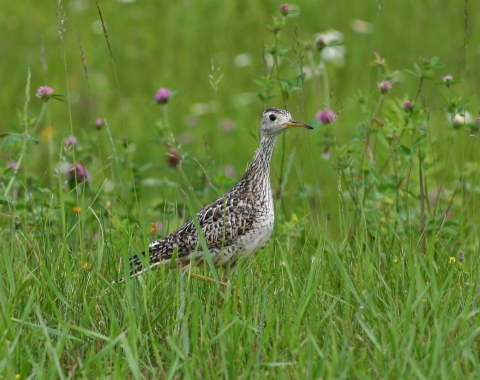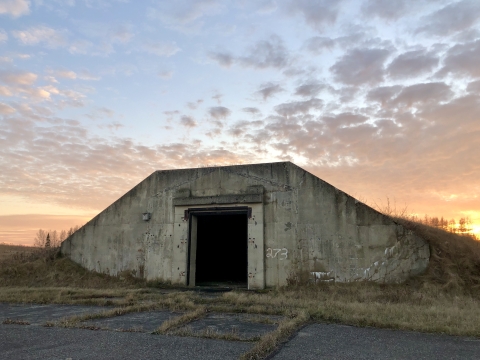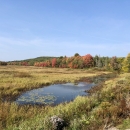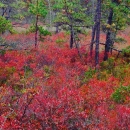About Us
Aroostook National Wildlife Refuge (NWR or refuge), located in the northeast corner of Maine, was established in 1998, when 4,700 acres was transferred from the US Air Force to the U.S. Fish and Wildlife Service. The refuge now consists of 5,252 acres in four divisions located in the towns of Caribou, Caswell, Connor, and Limestone. The refuge is also responsible for 1,464 acres of Farmer’s Home Administration Conservation Easements located throughout Aroostook County. Aroostook NWR is part of the Northern Maine National Wildlife Complex and is managed by staff at Moosehorn NWR.
The refuge consists of forests, grasslands, and wetlands that provide an oasis for wildlife in the surrounding agricultural landscape where potatoes and broccoli are among the most common crops. The open fields in the Weapon’s Storage Area on the East Loring Division provide nesting habitat for the State Threatened Upland Sandpiper.
Our Mission
The Mission of the US Fish and Wildlife Service is working with others to conserve, protect, and enhance fish, wildlife, plant, and their habitats for the continuing benefit of the American People. The US Fish and Wildlife Service's first priority on national wildlife refuges is protecting wildlife and its habitat.
Aroostook National Wildlife Refuge is managed to protect the Service's "trust resources" which include migratory birds, endangered species, and wetlands. By improving habitat, the Service ensures that wildlife will thrive on the refuge. Some of the management practices employed to achieve our goals include:
- Mowing of grass fields, and brushy areas
- Mapping and Controlling Invasive Plants
- Managing water levels to encourage desirable vegetation
- Cutting trees to mimic natural disturbances in the forest and maintain early growth forests
- Maintain open waterways to permit and enhance fish passage fish passage
Fish passage is the ability of fish or other aquatic species to move freely throughout their life to find food, reproduce, and complete their natural migration cycles. Millions of barriers to fish passage across the country are fragmenting habitat and leading to species declines. The U.S. Fish and Wildlife Service's National Fish Passage Program is working to reconnect watersheds to benefit both wildlife and people.
Learn more about fish passage - Restoring habitat by removing buildings, pavement, fences, and other infrastructure that were once part of the Air Force Base
Refuge staff also monitor environmental conditions and wildlife populations through surveys and studies that include:
- Local weather water quality monitoring
- American woodcock surveys
- Acoustic monitoring of bat species using the refuge
- Annual surveys of vernal pool obligate amphibians
- Monitoring of contaminant levels in refuge soil and water
Our History
Most refuge lands were once part of the Loring Air Force Base that was a critical military facility throughout the Cold War. The Strategic Air Command was stationed at the base from 1950 to 1994 flying long-range bombers capable of delivering nuclear weapons. Caribou Air Force Station was a top-secret, self-contained nuclear weapons storage base.
After the base closed, some of the lands were transferred to the US Fish and Wildlife Service to become the northernmost national wildlife refuge national wildlife refuge
A national wildlife refuge is typically a contiguous area of land and water managed by the U.S. Fish and Wildlife Service for the conservation and, where appropriate, restoration of fish, wildlife and plant resources and their habitats for the benefit of present and future generations of Americans.
Learn more about national wildlife refuge in the lower 48 states. The transferred lands contained lots of buildings, paved roads, parking lots, fencing, and other infrastructure. A major objective of the refuge over the past XX years has been to restore the habitat for wildlife by removing buildings and other infrastructure in a safe and environmental friendly manner.
Unfortunately, many areas had been contaminated by base activities and some areas still have high levels of PCB’s. This prevents allowing public fishing and hunting on refuge lands. Complex staff continue to work with partners to monitor the contaminant loadings and restore fish and wildlife habitat whenever possible.
Other Facilities in this Complex
The Aroostook National Wildlife Refuge is managed as part of the Northern Maine National Wildlife Refuge Complex, along with Moosehorn National Wildlife Refuge , Sunkhaze Meadows National Wildlife Refuge, and Carlton Pond Waterfowl Production Area.







